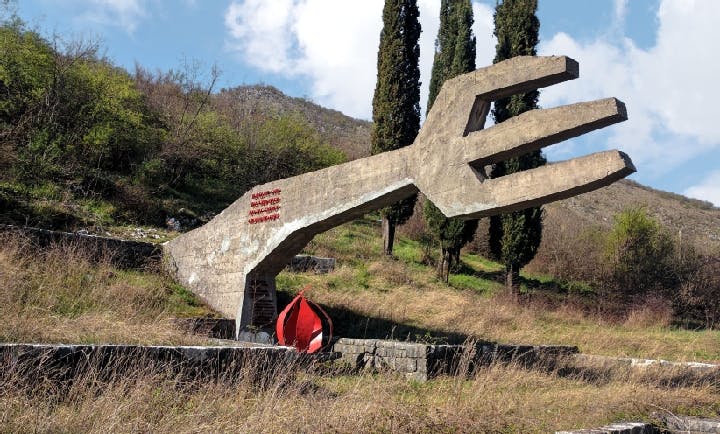Fall 2020
Monuments and Memory
– Dušan Veličković (Text) and Donald Niebyl (Images)
How did hard totalitarianism go soft in Tito's Yugoslavia? Acclaimed abstract commemorations of World War II offer clues to the transformation.
1
It was 1943 when Antun Augustinčić made his bust of Josip Broz Tito. A brutal war in Yugoslavia was in full swing, and the leader of the Partisan movement was declared a marshal of that nation. When Tito made a speech in front of the delegates of the Antifascist Council of the People’s Liberation of Yugoslavia on that occasion, the bust was next to him. Sculpted in wartime, it was no masterpiece. Rather, it was a hurriedly-sketched portrait in clay or gypsum.
Yet this was the moment in which the creation of a personality cult around Tito began. The start of creating a myth of liberation and revolution. It was also year zero in the history of the art of making monuments in a new Yugoslavia.
Over the next fifty or so years, many monuments were produced in Yugoslavia. So many, in fact, that a person might feel they were living in a cemetery. But Yugoslavia was not a campo santo. It was not a depressed country which did nothing but boast of its own heroic recent past.
Yes, Yugoslavia was a dictatorship, and a one-party police state. But it was also a joyful land, full of peculiar paradoxes and unexpected freedoms. A land where repressive totalitarianism was transformed into soft totalitarianism.
It was a country where one could have a happy childhood.
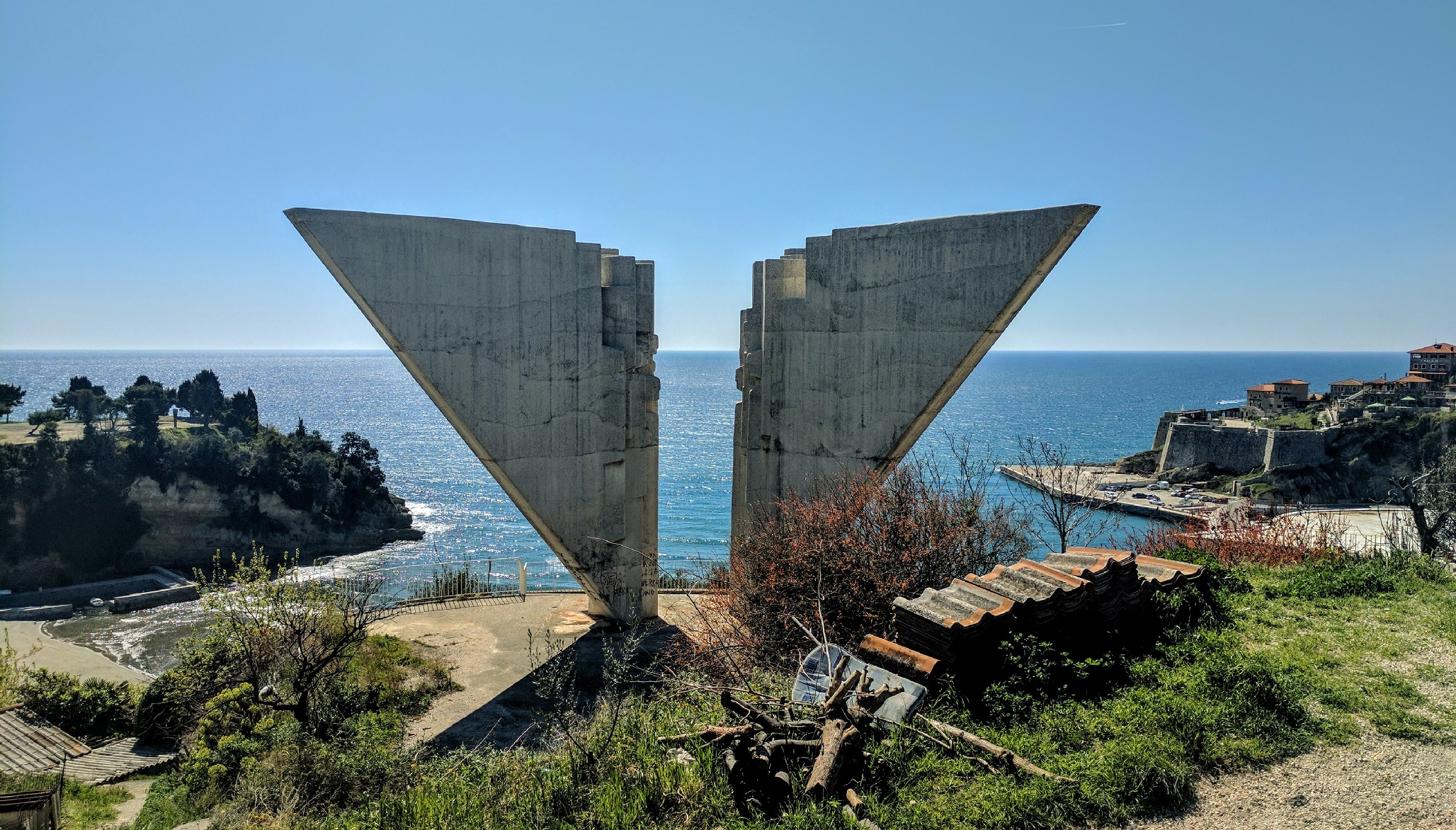
2
I remember very clearly one scene from my own early childhood. I was with my parents at a summer holiday at the island of Rab, and starting to speak my first words.
We had lunch in a large hall, where chess boards were imprinted on the tabletops. Glued to the entrance door was a piece of paper where THE HOUSE RULES were written in graphite pencil. My mother read the entire page out loud to me, including its closing proclamation (obligatory at the end of any official document): Death to fascism – Freedom to the people!
The place had a permanent smell of cabbages. Yet for lunch that day, we had crushed green peas and sardines from tin cans. As we ate, I heard a peculiar voice. Speechifying. Those who sat at the tables, stood up, and began to chant in rhythm, over and over again: “Tito – Party!”
I chanted, too: “Tito – Mama.”
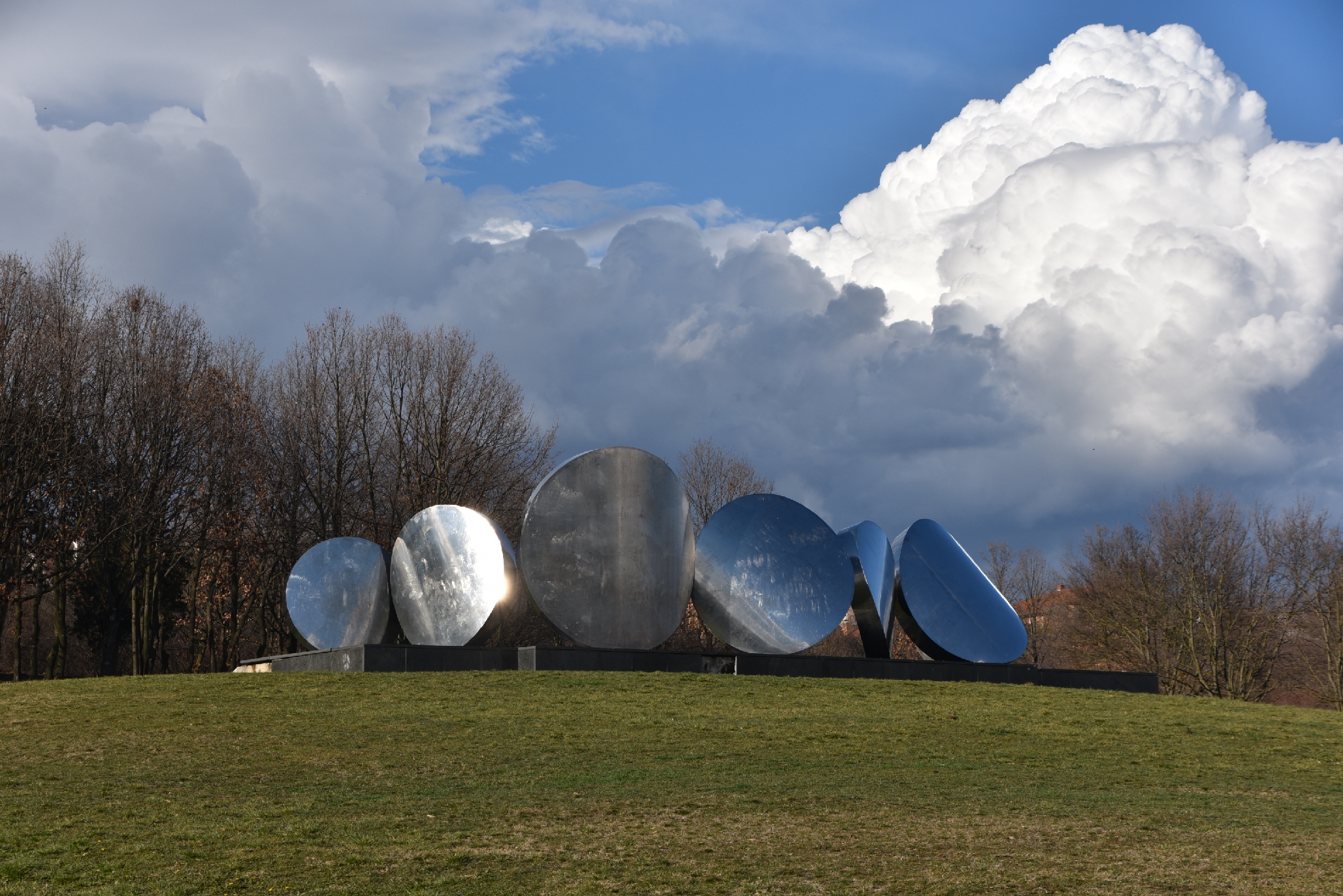
3
As I learned my first important words, Tito was finally rendered in bronze. A life-sized statue, artfully sculpted by Augustinčić. It depicts a stern and worried leader, with his military overcoat unbuttoned. He steps firmly forward, but he is lost in thought.
This statue was a clear indication that socialist realism would not last for much longer in Yugoslavia. At that moment, however, the nation was still in the thrall of Yugo-Stalinism. The clash between Tito and Soviet leader Joseph Stalin rolled the entire Yugoslav experiment back for a few years. Yugoslavia responded to Stalin’s threats and ultimatums with… Stalinism.
For time in the late 1940s and early 1950s, it appeared as though society was mired in political repression. Progress in culture and art also seemed to be stalled in socialist realist kitsch of the Soviet variety.
Traces of this era – the secret police, a vast army – lingered in Yugoslavia until the end of Tito’s life. So how did the local Balkan Stalinism of that era develop, over time, into a relatively tolerant society? A nation where there was a freedom of movement, and a modicum of free speech? A Yugoslavia where films could criticize the regime, and dissident books could be published?
Or, as we examine the monuments created in that time, how did Yugoslav society shift from Augustinčić’s statue of Tito to welcome a landscape where modernist abstractions of the highest artistic quality – such as Circles by Vojin Bakić, in Kragujevac – predominated?

4
When did hard totalitarianism end in Yugoslavia, and soft totalitarianism begin? It is hard to determine this precisely. Perhaps it was in the middle of 1960s, when we all could get passports and travel freely. Or perhaps much earlier. Say, in 1953, when a number of prominent artists in Belgrade established a group called MEDIALA, and clearly distanced themselves from any form of socialist realism.
As for me, that moment came when my father’s friend Radovan, from the village of Gluhi Dol, came to our home for a visit. He spent seven years imprisoned on Tito’s notorious island prison for pro-Soviet political dissidents: Goli Otok.
Radovan stayed in isolation for five years after his release. Before he arrived and rang our doorbell, we scrambled to hide a mug from which I drank milk. It had an inscription: Memory from Divčibare. A seemingly innocuous object, but it was essential that Radovan did not see it.
“They beat him in the head with just such a mug,” my mother explained. “Made of metal. In the prison camp.”
As he spoke with my parents, Radovan pulled a newspaper clipping from his pocket. He showed my father a photo.
In it, four middle-aged men stood on the deck of a large ship that was sailing on a Yugoslav peace mission to Africa. The name of the ship was “Galeb.” It was white. Everyone thought that the actual owner of the ship was Tito himself. Was this why Tito always dressed in white?
The caption read: Today, the elite educational vessel of the Yugoslav Navy carried the dearest voyager to a new journey of peace.
The men in the photo wore dark suits and neckties, with white shirts, and identical sun-glasses.
“Look at these treacherous ones,” he said. “Who sold their souls.”
Father took the photo, and held it at arm’s length to see the image more sharply. “To me they look more like actors from some movie,” he said.
“Yeah. A movie about the Mafia”, clarified Radovan.
Mother closed the window. She worried neighbors might hear.
“See, Milivoje, those are all intellectuals,” added Radovan contemptuously. “Do you know they all have identical underpants? They get them free from the state-owned warehouse.”
“It’s hard to purchase any clothing item, these days,” replied my mother. “They represent our country, and they must be decently dressed when they meet with the representatives of friendly African countries.”
“That’s the first rule every dictator learns,” said Radovan. “Everybody must look the same, except for him.”
Mother put a finger to her lips. “The walls have ears here,” she said.
“Stalin was a dictator, too,” said my father. “Yet he did not wear white suits.”
“Stalin’s something else,” observed Radovan. “Without him, the great Russian nation would still be in the nineteenth century.”
Father replied: “Like hell, they would.”

5
One of the men in dark suits on the deck of the “Galeb” was the writer Dobrica Ćosić. During World War II, Ćosić was a political commissar for the Partisans who became a main propagandist for the new regime when Tito took power. Subsequently, he became one of Yugoslavia’s most influential writers.
Near the end of the 1960s, however, Ćosić found himself in conflict with Tito. He became a leading Yugoslav dissident. Nationalism was his sin against the regime, but its adherents – particularly in Serbia – saw him as a Solzhenitsyn-like figure.
Other prominent Yugoslav dissidents, such as Milovan Đilas and Mihajlo Mihajlov, spent many years in jail. Ćosić did not. His great popularity as a writer helped shield him. He wrote historical novels, steeped in tradition. These books were extraordinarily popular with readers, not only in Serbia, but all over Yugoslavia.
Yet Dobrica Ćosić’s destiny was also determined by the circumstances that prevailed in Yugoslavia at that precise moment. It was shortly after the Prague Spring of 1968, when people began to speak of a socialism with a human face. Long-held taboos wobbled.
Quite simply, Yugoslavia had set sail into the waters of a very soft totalitarianism. It was a course set not only by pro-Western dissidents such as Đilas and Mihajlov, but also by conservative nationalists such as Ćosić. In this liberated atmosphere, many such “surprises” emerged in art and culture.
The flowering of these new abstract monuments to events of the Second World War was among them. It is my belief that these surprisingly modern works – in futuristic, abstract, Brutalist or Cubist forms – are monuments to that era’s soft totalitarianism. I don’t deny the paradox of a nationalist such as Ćosić contributing to this movement. That is how things go when you begin to disassemble totalitarianism.
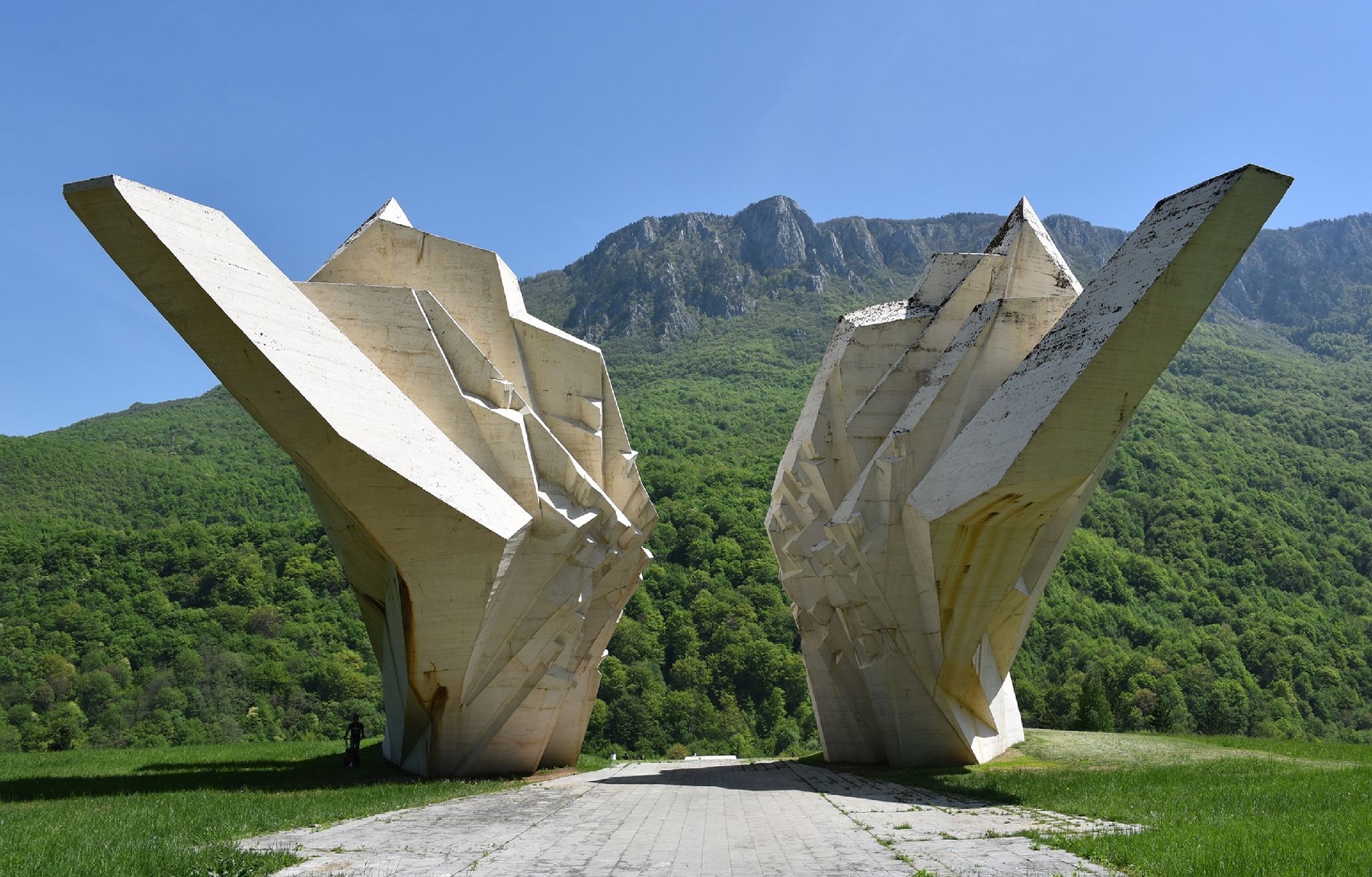
6
Near the end of the 1980s, I spent a few days with Dobrica Ćosić.
In one of our conversations, he admitted that Radovan’s story was true. The men who sailed around Africa on the “Galeb” did receive a complete set of clothes from a specialized state-owned warehouse. They were goods given only to a privileged nomenclature.
It may sound comical that Tito’s entourage, including prominent politicians and intellectuals, wore identical clothes. Right down to their underwear. But what it tells me is that in that moment, in Tito’s Yugoslavia, nothing was left to chance.
That time with Ćosić came at a PEN Congress in Bled, a lake town in Slovenia. One day, we traveled together to see a monument to Tito in a nearby town named Velenje, which boasted one of the largest versions of Augustinčić’s Tito statue in the world.
We talked about monuments that day. Ćosić told me Tito had good instincts. Yugoslavia’s leader realized how valuable Augustinčić’s statue had been in shaping his image. That is why Yugoslavia erected so many copies of it in so many municipalities.
Controversies over the newer monuments in Yugoslavia also came up as we talked. We discussed the memorial at Tjentište in Bosnia-Hercegovina. Ćosić argued that Tito did not know much about art. But he insisted that the leader did readily understand the value of abstract sculptures of the sort created by Miodrag Živković, including this particular commemoration of a key battle in the Sutjetska River valley in 1943.
It was in this place that Partisan forces managed to break out of an encirclement by Nazi troops. But the monument at Tjentište bears no image of Tito, nor of Sava Kovačević – a Partisan commander who died nearby fighting German forces. Rather, the imposing concrete creation reminds us of the canyon, and the bravery of the men who fought there.
This monument also does not depict other circumstances of this battle – including the fact that Tito’s poor strategy at the beginning of the campaign allowed his troops to be surrounded and caused many Partisan troops to die unnecessarily. The abstract nature of the Tjentište monument also elides any mention of Koča Popović – who devised the plan to rescue Tito and his troops from their desperate position.
When I read Popović’s Diaries years later, I discovered that Tito hesitated to issue the order for a breaking out of the enemy encirclement. He wrongly believed that Allied forces would arrive to help him. It was Popović who gave the order on his own initiative for the First Proletarian Brigade to break through the Nazi lines. Those allied troops? They never arrived.
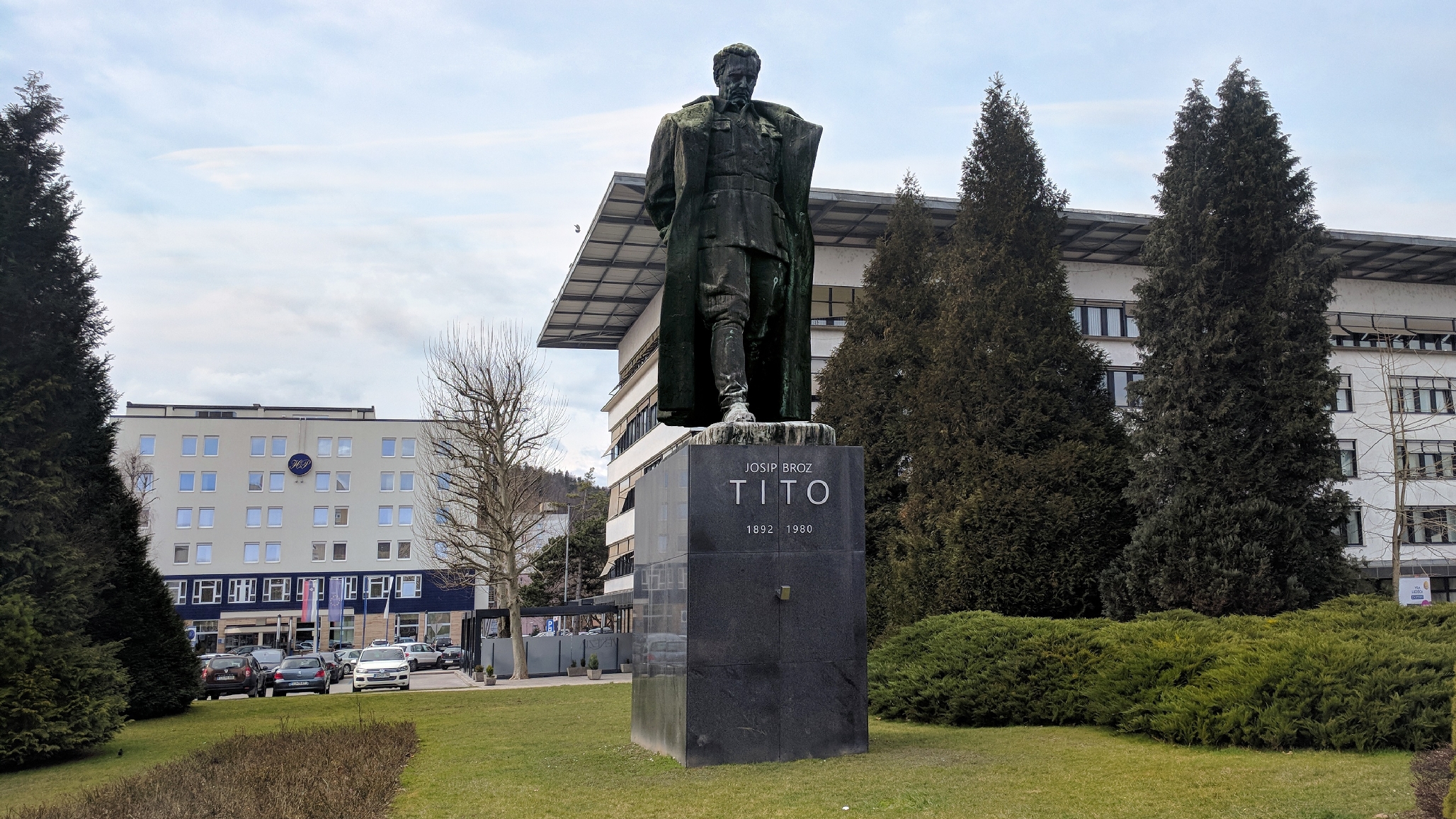
7
The political advantages of abstract modernism are clear. But it does not explain fully the proliferation of these groundbreaking monuments, or how they became the dominant artistic style of that era in a socialist country permeated with dogmas and taboos.
The process of local globalization in the Balkans had clear principles. And the Yugoslav “glocal” world rested on very simple and very clear national taboos that would be punished if violated.
The first and greatest taboo was to attack Tito personally. Yugoslavia’s leader was sheltered not only from any serious criticism, but from any public disagreement. In practice, one could be thrown in jail for making a joke about Tito. Anything clearly associated with Tito was also protected in this way.
I remember one moment from elementary school. In some childish horseplay in the corridors, I accidentally knocked down a small bust of Tito. It was a sculpture that was ubiquitous in every public place. My accident became an immense scandal. It was unclear who was more afraid: the teachers in whose school it happened, or I, being accused of an (almost) terrorist intent in knocking it down.
My father was called to the school for multiple times for discussions and warnings. It must not happen again. Ever. I was impressed by how calmly my father explained that it was only a childish and unruly moment, and how he labeled threats to call upon the secret police to get involved as pointless.
It helped that my father was a lawyer with a great deal of experience in the methods and thinking of communist authorities. He had been expelled from the Party because of a “disagreement” with the leadership. Once, he had even spent a night in jail for being overheard criticizing the Conference of Heads of State of Government of Non-Aligned Countries in a pub.
The second taboo was critiquing the so-called leading role of the Communist Party. This followed logically from the first taboo, and in practice meant that any attempt to form an alternate political party was a mortal sin. Indeed, for many years, almost no one even thought of trying.
Over time, this taboo became rather meaningless. As the one and only political party in Yugoslavia, the Communist Party acquired so many members that it began to circulate differing political views within its own circles. Eventually, the slogan about the “leading role” of the Party served mainly to push the differences under a carpet.
The concept of “brotherhood and unity” was the third taboo. Any and all nationalism and chauvinism was punishable. In this matter, repression was meaningful; we could almost say that there was a convertibility of aims and means. This repression sustained the glocal character of Yugoslavia, a mix of global and local in the small but complicated Yugoslav space. But as history later revealed, this also served only to shove real problems under the carpet.
These taboos were not the strictest of dogma. Stalinism was over, after all. But they offered a secure framework within which Yugoslav socialism could develop.
Post-war monuments played a key role in this project. A culture of remembering and commemorating the antifascist and freedom-loving past was nurtured, carefully, and constantly. Hannah Arendt observed that the past is never dead, that it is never even the true past. For an edifice as complex as Yugoslavia was, memories of a recent, glorious past were not instructions for behavior – or for success. They were an attempt to teach us who we are.
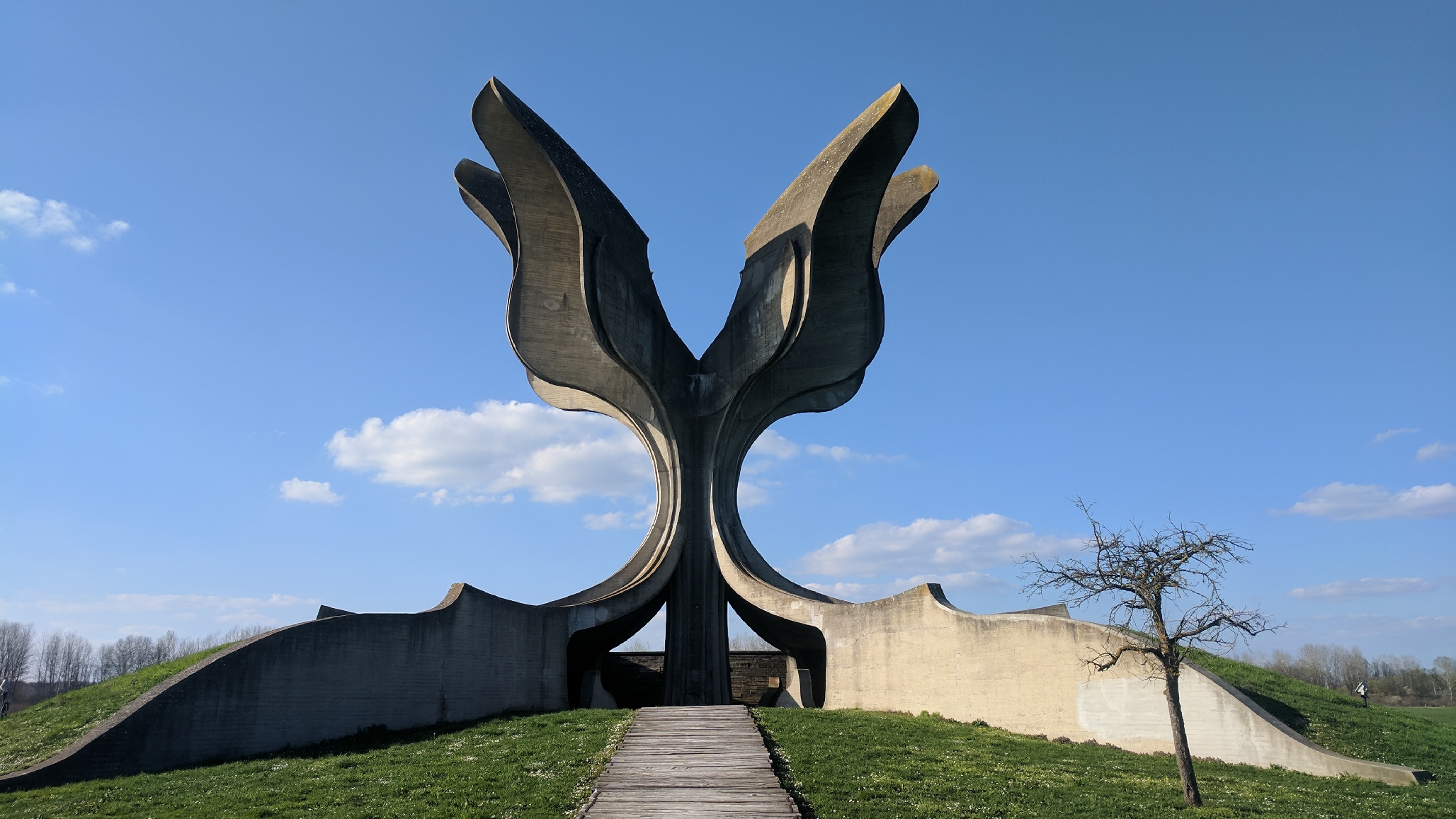
8
These abstracted post-war monuments did not spring up by themselves. The admirable modernism of the socialist art of commemoration in that era also was not spontaneous, and the emergence of talented sculptors and architects who created it was no accident.
Large projects such as the monument in Tjentište, or the “Stone Flower” in Jasenovac, or the magnificent monuments designed by Dusan Džamonja in Moslavina and in Kozara, or the memory park in the Šumarice, required large amounts of money. They were important for the State, and created occasions for serious debates, dilemmas and competition – as well as behind-the-scenes political machinations.
I remember my long conversations with Džamonja in the town of Pula. The film festival in that small town in Istria was the gathering place for many, widely differing, artists and intellectuals. Džamonja was already recognized as a great artist, and showed me his sketches for a monument to commemorate the Sremski front, in Adaševci.
Džamonja complained that the Yugoslav state had postponed a decision on financing his project for a number of years. He suspected that the government was hesitating because of a contemporary political debate. Some historians were beginning to argue that the battle of the Sremski front was an unnecessary, suicidal action for which Tito was personally responsible.
His vision was never realized. Ten years later, in the late 1980s, a Sremski front monument was built. It was based on the idea by the sculptor Jovan Soldatović. It was the last such memorial built in Yugoslavia, and in a time of immense and growing political intrigue, there were rumors that Soldatović’s selection was as political as it was artistic.
Even in less complicated situations, these memorials were hard to create. The character of the events they commemorated played a role. Heroic battles and victories, regardless of subsequent interpretations of strategy and command, are one thing. It is quite another thing to memorialize the mass crimes committed in the death camp of Jasenovac during the Second World War.
Indeed, the culture of remembrance to which Yugoslavia had devoted itself so assiduously faced an almost insoluble problem in commemorating Jasenovac. How does one square the principle of brotherhood and unity with a monument marking the site of horrendous war crimes rooted in ethnic intolerance? Scholars argued bitterly about the number of victims murdered at Jasenovac. Attempts were made to magnify and minimize the death toll there.
Croatian historian Dragan Markovina believes that Tito never visited Jasenovac because of these conflicts and contradictions. Yet Tito himself gave the final approval for the monument. After considering a number of differing proposals, Tito accepted a proposal made by Bogdan Bogdanović – a “stone flower” that was “abstract and full of dynamism.”
The superlative aesthetics and lyrical atmosphere of this monumental concrete sculpture offers a genuine hint of the need, as Bogdanović himself argued, to achieve a reconciliation and a final departure from a continuous “hatred carried from generation to generation.”
Yet some people may feel that the vigorous “stone flower” of Jasenovac lacks the warning to the future expected at such a site. I felt something similar as I stood on the new memorial to the Murdered Jews of Europe in Berlin, near the Brandenburg Gate. This abstract concrete structure, a gradually rising labyrinth of many slabs, invites different emotions than the “stone flower.” Yet, it is set in a completely different, and very urban ambience. Perhaps it is best to visit both monuments to judge the case.
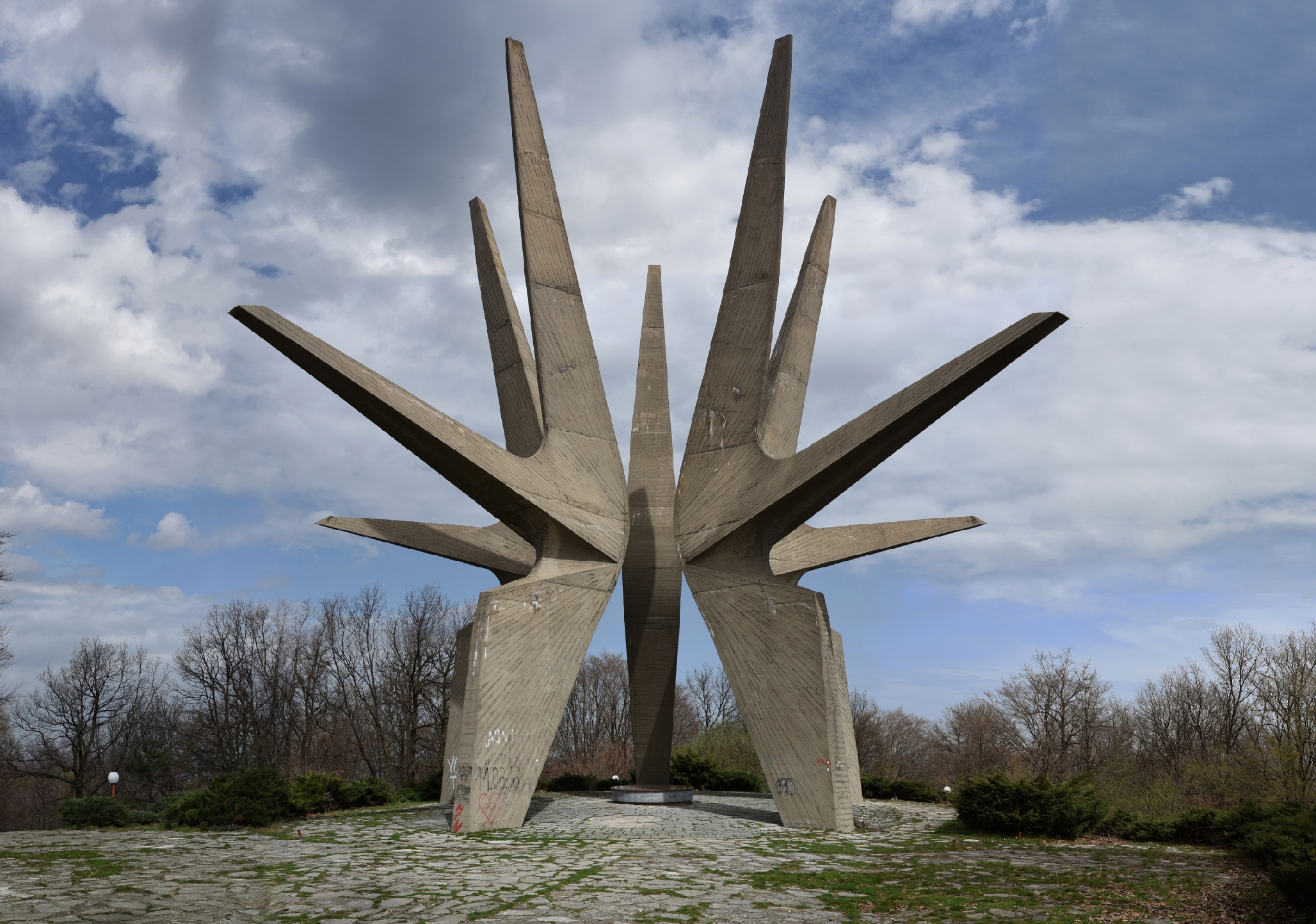
9
The era of socialist modernism in monuments ended with the disintegration of Yugoslavia. Bogdan Bogdanović went into exile. Dobrica Ćosić was, for a short time, the president of the Federal Republic of Yugoslavia. As far as new monuments, the boldness of vision had gone. Kitsch had returned.
Even from a distance, it is possible to meditate upon how it was possible, in a country at the edge of the Iron Curtain, for such a fascinating wave of abstract modernism to appear.
Both Ćosić and Bogdanović rejected a decisive role for Tito. I think they are both wrong. When he completed his ambition to create a cult of his own personality, Tito yielded to the joys of soft totalitarianism. Or, as Kolakowski says in The Main Currents of Marxism: “In Tito’s Yugoslavia there is much more freedom than in the countries of the Eastern bloc, but, also, the greatest number of political prisoners”.
The culture of remembrance was one of the sources of his power. Yet it offered a space that was open to a completely new modern approach. I believe that each of the many abstract constructions had at least a marginal blessing by Tito himself. It is enough to look at a photo where Tito, together with the powerful chief of police, listens carefully to Miodrag Živković as he presents the concept for the monument at Sutjeska.
If I were a commercial writer, I think I could, on the basis of that one photograph, write an exciting thriller about the monuments in Yugoslavia. Maybe something under the title: Looking for YU Artpop. If Lady Gaga wouldn’t mind.
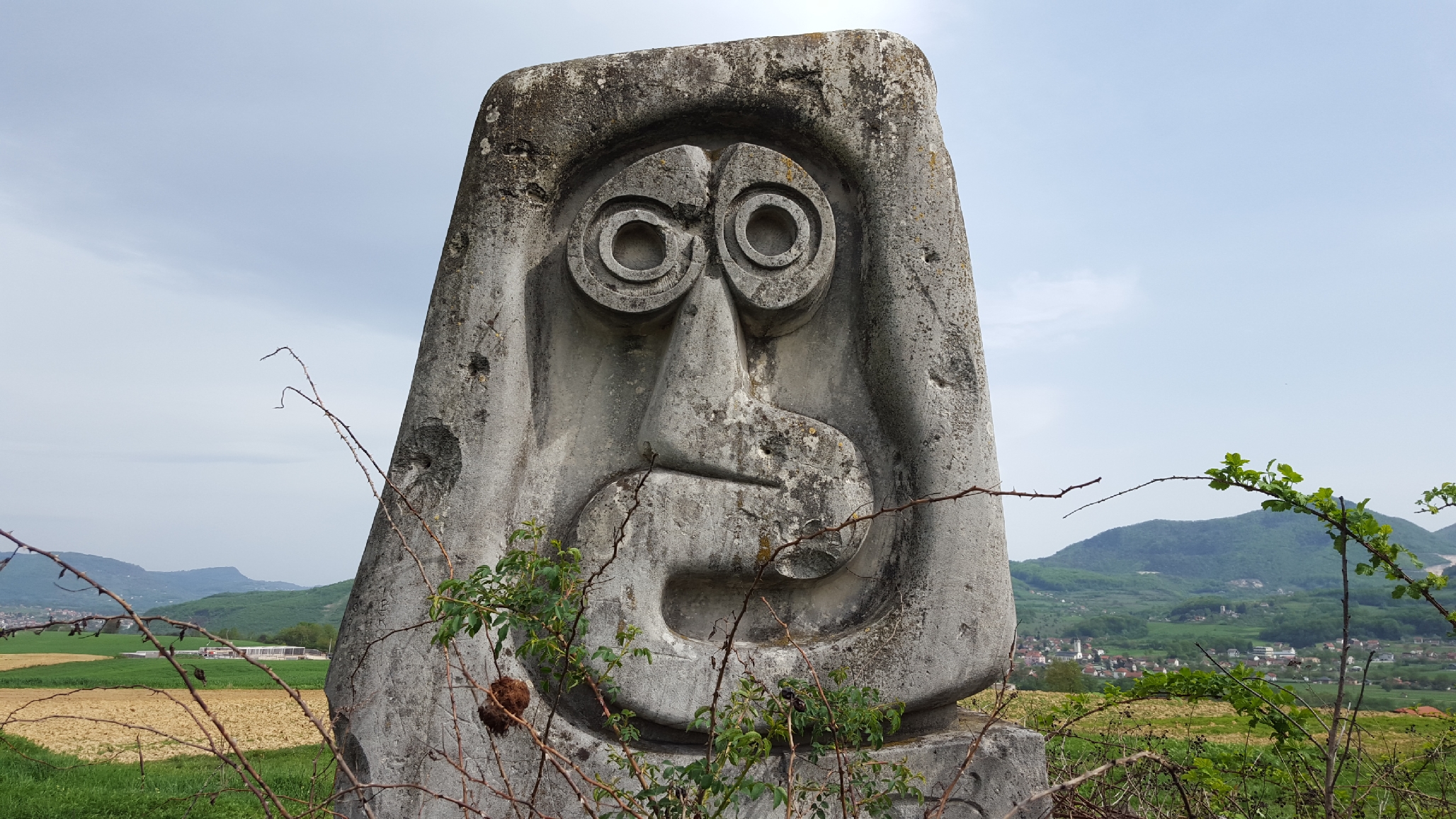
Dušan Veličković is an author and filmmaker. He lives in Belgrade. His books include: Slike Sumnije; Amor Mundi: Days of Bombardment and Martial Law in Belgrade, True Stories; Internationale; Djindjic; Serbia Hardcore; Bella, ciao; and Balkan Pin-Up. He received the International Award for Freedom (Premio Internazionale alla Liberta) from the Società Libera in 2009.
Donald Niebyl is the creator of Spomenik Database - the definitive and critically-acclaimed website on the "spomenici" of former Yugoslavia. His book on these artworks, Spomenik Monument Database, was published in 2018 by Fuel. Click on the images above to reach a page of essential information about each monument's history and design.
Cover image: The Monument to Hanged Patriots - also known as "The Fork" ( 1970s) in Vranjske Njive, Montenegro. Designed by Milorad 'Mišo' Vukotić.
